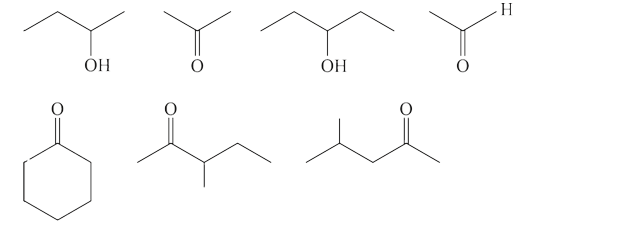The optically inactive compound from the following is :-
2-chloropropanal
2-chlorobutane
2-chloro-2-methylbutane
2-chloropentane
The correct Answer is:C
To determine the optically inactive compound from the given options, we need to identify which compound has a chiral carbon and which does not. A chiral carbon is a carbon atom that is bonded to four different groups. If a compound has at least one chiral carbon, it is considered optically active. Conversely, if a compound has no chiral carbons or has a carbon bonded to groups that are not all different, it is optically inactive.
Let’s analyze each option step by step:
Step 1: Analyze 2-Chloropropanol
- Structure: CH3-CHOH-Cl
- The carbon atom attached to the hydroxyl group (OH) is bonded to:
- CH3 (methyl group)
- OH (hydroxyl group)
- Cl (chlorine)
- H (hydrogen)
- Since all four groups attached to this carbon are different, this carbon is chiral.
- Conclusion: 2-Chloropropanol is optically active.
Step 2: Analyze 2-Chlorobutane
- Structure: CH3-CH(Cl)-CH2-CH3
- The carbon atom attached to the chlorine is bonded to:
- CH3 (methyl group)
- Cl (chlorine)
- CH2 (methylene group)
- CH2 (methylene group)
- This carbon is also bonded to four different groups, making it chiral.
- Conclusion: 2-Chlorobutane is optically active.
Step 3: Analyze 2-Chloro-2-methylbutane
- Structure: CH3-C(Cl)(CH3)-CH2-CH3
- The carbon atom attached to the chlorine is bonded to:
- CH3 (methyl group)
- Cl (chlorine)
- CH3 (methyl group)
- CH2 (methylene group)
- Here, two of the groups are the same (two CH3 groups), which means this carbon is not chiral.
- Conclusion: 2-Chloro-2-methylbutane is optically inactive.
Step 4: Analyze 2-Chloropentane
- Structure: CH3-CH(Cl)-CH2-CH2-CH3
- The carbon atom attached to the chlorine is bonded to:
- CH3 (methyl group)
- Cl (chlorine)
- CH2 (methylene group)
- CH2 (methylene group)
- This carbon is also bonded to four different groups, making it chiral.
- Conclusion: 2-Chloropentane is optically active.
Final Answer
The optically inactive compound from the options provided is 2-Chloro-2-methylbutane.
---
- Structure: CH3-CHOH-Cl
- The carbon atom attached to the hydroxyl group (OH) is bonded to:
- CH3 (methyl group)
- OH (hydroxyl group)
- Cl (chlorine)
- H (hydrogen)
- Since all four groups attached to this carbon are different, this carbon is chiral.
- Conclusion: 2-Chloropropanol is optically active.
- Structure: CH3-CH(Cl)-CH2-CH3
- The carbon atom attached to the chlorine is bonded to:
- CH3 (methyl group)
- Cl (chlorine)
- CH2 (methylene group)
- CH2 (methylene group)
- This carbon is also bonded to four different groups, making it chiral.
- Conclusion: 2-Chlorobutane is optically active.
- Structure: CH3-C(Cl)(CH3)-CH2-CH3
- The carbon atom attached to the chlorine is bonded to:
- CH3 (methyl group)
- Cl (chlorine)
- CH3 (methyl group)
- CH2 (methylene group)
- Here, two of the groups are the same (two CH3 groups), which means this carbon is not chiral.
- Conclusion: 2-Chloro-2-methylbutane is optically inactive.
- Structure: CH3-CH(Cl)-CH2-CH2-CH3
- The carbon atom attached to the chlorine is bonded to:
- CH3 (methyl group)
- Cl (chlorine)
- CH2 (methylene group)
- CH2 (methylene group)
- This carbon is also bonded to four different groups, making it chiral.
- Conclusion: 2-Chloropentane is optically active.
The optically inactive compound from the options provided is 2-Chloro-2-methylbutane.
Topper's Solved these Questions
- ALKENE, ALKANE & ALKYNE BOOK - ALLENCHAPTER - ALKENE, ALKANE & ALKYNE EXERCISE - EXERCISE-5[B]
165 Videos
- ALKENE, ALKANE & ALKYNE BOOK - ALLENCHAPTER - ALKENE, ALKANE & ALKYNE EXERCISE - EXCERSISE-1
25 Videos
- ALKENE, ALKANE & ALKYNE BOOK - ALLENCHAPTER - ALKENE, ALKANE & ALKYNE EXERCISE - EXERCISE-5
58 Videos
- AIIMS 2019BOOK - ALLENCHAPTER - AIIMS 2019EXERCISE - CHEMISTRY
40 Videos
- ALKYL AND ARYL HALIDEBOOK - ALLENCHAPTER - ALKYL AND ARYL HALIDEEXERCISE - EXERCISE-05 (B)
35 Videos
Similar Questions
Knowledge Check
An optically active compound
Arotates the plane of polarised lightBchanges the direction of polarised lightCdoes not allow plane polarised light to pass throughDnone of these.
Identify the compound that on hydrogenation produces an optically active compound from the following compounds :

View SolutionNumber of optically active compounds out of following that can give Haloform reactions.

View SolutionThe formation of an optically active compound from a chiral molecule is called:
View SolutionWhich is optically inactive?
View SolutionReduction of hexose A (molecular formula C6H12O6) with sodium borohydride gives compound B and C. Compound B is optically inactive, whereas compound C is optically active. Which of the following is compound A?
View SolutionAn optically active compound A with molecular formula C8H14 undergoes catalytic hydrogenation to give an optically inactive product. Which of the following structures for A is/are consistent with all the data?
View SolutionOptically active isomer (A) of (C5H9Cl) on treatment with one mole of H2 gives an optically inactive compound (B) compound (A) will be :
View Solution
